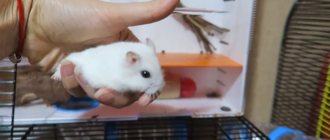One of the most popular, but short-lived pets is the hamster. Cute little ones who are always running somewhere seem to be in a hurry to live. And this is not without reason, because on average hamsters live about two years, and with good care they can live up to three. Any owner who chooses to keep this cute animal will almost inevitably face its death. So what standards should you follow to ensure your pet lives a long and happy life? And what to do if the hamster died?
Correct content
First, let's look at how to properly keep a hamster, because poor living conditions can cause death.
If you want to create ideal living conditions for your pet, you should not seek advice from sellers and consultants at pet stores. Often these people do not have specialized training and are interested in getting as much money as possible for goods, even if in the end they may cost your pet's life.
To keep your hamster healthy, it is important to choose the right cage. A high cage is dangerous, as hamsters like to climb up the bars under the roof and fall from there, seriously injuring themselves.
The cage should be spacious. Minimum bottom dimensions:
- for dwarf species – 50*30 cm;
- for Syrian hamsters – 60*40 cm.
The minimum size means that it is advisable to take a larger cage along the bottom, but not smaller.
Equally important is a running wheel of the correct size:
- for a dwarf hamster, the wheel diameter is from 16 cm;
- for a Syrian hamster – from 18 cm.
You shouldn’t take two hamsters with the motivation “so that one doesn’t get bored.” Hamsters are territorial animals. There is a high probability that one day, instead of two pets getting along, you will see a bloody battle with a fatal outcome. This applies to both different-sex and same-sex hamsters.
Do not engage in uncontrolled breeding of hamsters. Pregnancy seriously shortens the life of the female, and in some cases can lead to the death of her and her babies. Hamsters are famous for the fact that they can easily eat their offspring.
Hamsters should not be bathed in water. They need special sand for bathing.
After death a hamster: what you should never do
When a pet dies, a person does not always know how to behave. First reactions and actions are often wrong and can lead to negative consequences. What not to do:
- withdraw into oneself, avoid any conversation and communication, and for a long time;
- drinking alcohol is one of the ways to escape from reality, to replace it;
- throw away things related to the hamster: the death of an animal causes pain, and a person tries to eliminate its cause, but over time he may regret what he did;
- immerse yourself in work, other activities, and not experience the feelings that arise;
- concentrate on your pain, forgetting that other family members are also experiencing and need support, because together it will be easier to endure the loss.
Proper nutrition
There is a wide variety of food for rodents on display at pet stores. However, despite what the labels say, not all of them are created equal. Cheap food is not suitable for feeding hamsters - they are usually of poor quality, incorrectly balanced, and do not contain all the necessary substances and vitamins. There have been cases where rodent poison was found in food, which caused the death of pets.
For normal functioning, hamsters need balanced dry food. It should include cereals, plant seeds, herbs and flowers, as well as protein supplements in the form of dried insects.
It is important to give hamsters allowed vegetables and fruits. You can feed hamsters cucumber, zucchini, broccoli, cauliflower, lettuce, turnips, radish. Types of hamsters that are not predisposed to diabetes can be given pumpkin, carrots, fruits and dried fruits.
It is forbidden to give onions, white cabbage, sorrel.
Temperature-related disorders
If the hamster did not show the slightest signs of illness and suddenly fell into an unconscious state, it may be hibernating. In the natural environment, Djunga hamsters retire in winter, experiencing cold weather, periods of lack of food and insufficient lighting. The other extreme is overheating of the hamster, and this is much more dangerous than cooling, since the small animal is absolutely defenseless against high thermometer readings. It is overheating that most often becomes the cause of death for a rodent.
Low room temperature
Turning off the heating or leaving a window open for a long time on a frosty day can cause the hamster to fall into torpor. In this case, the body will be very cold, and the heartbeat will slow down significantly - to one beat every fifteen seconds. A sleeping hamster barely breathes and due to its small size it is quite difficult to determine how intense the breathing is and whether it exists at all. But if the body is soft to the touch, this means that the rodent is alive.
To awaken it, you need to move the cage to a room with a temperature above +20 degrees. The hamster will wake up in 2-3 days and care should be taken that the feeder and drinker are full when he wakes up.
This is especially important, since during hibernation a rodent wastes a very large amount of energy and its health will depend on how quickly it replenishes it with food. A hamster left hungry after hibernation may develop serious liver problems.
This method of awakening is optimal, since it is close to how a hamster wakes up from hibernation in its natural environment, but the process can be accelerated:
- Wrap the hamster in a warm cloth or down mitten, place it in a cage and move it to a room with a high temperature.
- Fill several bottles with hot water, place them in a row and place the cage on them. Heat will be transferred through the bottom, warming the hamster
Heat
Exposure to high temperatures has an extremely negative effect on hamsters. These animals have very dense fur and completely lack protection from overheating - they do not sweat and cannot breathe through their mouths.
You can tell that a hamster is overheated by the fact that it does not move and is breathing heavily, or its coordination of movements is impaired and it is generally weakened.
Heatstroke can be caused by the following situations:
- Transport by car
- A cage placed on a windowsill or balcony so that the hamster is exposed to direct sunlight
- The animal's house is located next to the heating devices
- There is not enough air in the room where the hamster is located and it is very humid
If you decide to get a hamster, remember that they do not live long - about two to three years, after which they inevitably die. But under the influence of certain factors, the animal may die earlier. However, not every owner knows what to do and how to help their pet.
Hamster injuries
Hamsters are fragile animals, and therefore there is a high risk of receiving all kinds of injuries in the process of life.
Hamsters often suffer injuries and broken limbs. This is due to high cages with floors made of rods. Also, the cause of broken limbs can be running wheels with a large mesh - a hamster's paw can get stuck in the wheel while running, and the result will be a fracture or amputation of a limb. Cotton wool or fabrics in a cage are very dangerous. The small paw may become entangled in the fibers and dry out, causing the hamster to chew it off.
Walking balls pose a great danger. They are strictly contraindicated for hamsters. Running in a ball, a hamster can suffocate, overheat, or get injured.
Serious injuries have been caused by fights between hamsters kept together.
Eye injuries from sharp objects or splinters are common.
Another danger for a hamster are other pets: cats and dogs. It is important to place the cage where other animals cannot reach it. Often cats and dogs drop cages or reach hamsters with their claws through the bars.
Hamsters do not feel heights, and therefore are not afraid of them. There are frequent cases when a hamster jumps from one's hand onto the floor, resulting in serious injuries.
Reply to the post “Challenges in the Spirit of Jesus”
We once had Syrian hamsters. Two - a male and a female. They gave birth to cubs, three or four of them. We fed them, cleaned their cage, everything was calm. But at one point everything did not go according to the scenario of a happy hamster family. It started with the fact that the mother of the family fell ill, did not eat anything, and moved little. We fed the hamsters well with oats, corn, wheat, greens, carrots, etc. But they always had little food, or they did not like such food at all. The next day, after the hamsters’ mother began to get sick, my wife and I came home from work, I went into the room where there was a cage with hamsters and saw real chaos in the cage - all the hamsters were rushing around, attacking each other, the hamster’s mother was lying in the corner of the cage and cracks. And in the center of the cage lies a red shredded tomato, to which the hamster brothers and sisters periodically run up to refresh themselves. I ask my wife when she managed to throw a tomato to the hamsters. She replies from the other room that she didn’t give them any tomatoes. And only then, having taken a closer look, I look at the small spine sticking out of the tomato. And I understand that this is fucking not a tomato. It was the most disgusting and unpleasant thing I have ever seen in person in my life. Just a piece of fresh meat with barely visible bones, no fur in sight, and the head, apparently, had been eaten by the poor hamster's siblings. I confess that I was a bad owner and, apparently, turned out to be a bad person, because the only thing I could do in this situation was to stuff the cage into a potato bag, holding back the urge to vomit, and take the bag to the trash. I first opened the cage; it is possible that the hamsters were able to safely get out of the cage and found freedom. But I didn’t really care anymore; I wanted to forget this sight as quickly as possible. I read articles on the Internet and came to the conclusion that it is not advisable for Syrian hamsters to live as a family in one cage. Or you could read about the characteristics of Syrian hamsters in advance. ¯\_(ツ)_/¯
Hamster diseases
In order to avoid the irreparable in time and contact a veterinarian, it is worth knowing what illnesses pet hamsters suffer from.
As a result of constant running in a small running wheel, the hamster's spine becomes bent and its internal organs are displaced. The animal gets sick and dies.
It has been recorded that living in a small cage can cause a hamster to fail in its hind legs. Small cages have a detrimental effect on the hamster's mental state and can cause inappropriate behavior and more serious illnesses.
When using pine litter in a cage, a hamster may develop an allergy. To keep a hamster, you should use corn flakes, fruit tree sawdust and cellulose filler. Needles are poison. It can cause respiratory diseases.
Hamsters are very afraid of drafts and cold; they are susceptible to colds. It is highly not recommended to take your hamster outside or let him play in the grass. In addition, “in the wild” a hamster may well pick up parasites.
Benign and malignant tumors are common in hamsters, especially in older ones. The reason for their appearance may well be poor quality food. Any tumor that forms in a hamster will not resolve on its own, and your pet must be shown to a veterinarian.
Campbell's hamsters are prone to diabetes, and therefore they must be kept on a special diet - do not give sweet vegetables and fruits, and exclude corn from the diet. As a result of crossing Campbell and Djungarian hamsters, it is now difficult to find pure line Djungarian hamsters in pet stores, which means that many of them are also prone to diabetes. Therefore, if you are not absolutely sure of the purity of your dwarf’s blood, it is advisable to feed it in accordance with a special diet.
Any changes in your hamster's health should not go unnoticed. If your hamster has any discharge, tumors, damaged limbs or hair loss, this is a direct indication to take the animal to the veterinarian. Don’t delay, because every minute can count.
Causes of hamster death
When a pet dies, over time the desire to have another appears. Hamsters do not live long, so you should prevent the possibility of the slightest impact of negative external factors in the future:
1 age: nature provides certain functions, features of the life support of the body of living beings; in hamsters, internal organs can work for no more than 2-3 years, even if ideal conditions for existence are created, this is the average duration of the period during which the natural process of maturation and aging of the body occurs;
2 improper nutrition: hamsters react poorly to low-quality food, this means that you cannot give them rotten vegetables, as well as exotic fruits, sour, salty, smoked foods, snacks (chips, crackers, etc.), spicy foods are also prohibited, do not you should offer your pet food that will have a bad effect on a small body, including semi-finished products, ready-made food containing preservatives, dyes;
3 colds: the life of a hamster depends on the conditions of detention, because these animals are highly susceptible to temperature changes, ultraviolet radiation (direct sunlight), swimming in water is harmful to the pet, it is important to prepare special sand for this, and the ambient temperature was +20... +22°C, the animal must not be hypothermic;
4 other diseases: a hamster can get sick from eating excess amounts of sweets, this contributes to the development of diabetes, in addition, there is a risk of developing tumors, while the symptoms of the disease are not always obvious, much more often animals are exposed to infections, which also contributes to a shortening of life;
5 constant stress: it is not so difficult to bring a hamster to a heart attack or stroke, these animals are susceptible to stress, it is enough to scare them sharply, for example, by turning on the light, clapping your hands, the hamster reacts poorly to the appearance of large animals (cat, dog), even when they are calm presence puts small pets into a state of stress, not to mention loud barking;
6 improper care: it is necessary to remove excrement, change the bedding, thanks to this the risk of developing infectious diseases is reduced, it is still necessary to control the pet’s supplies, the hamster collects food in bins, but the air temperature in the room is quite high, they can spoil, however, you cannot throw away the animal’s food , he will experience stress, you need to change supplies to fresh food;
7 injury: a hamster is a fragile creature, the slightest careless blow, a fall can lead to injury, you should not squeeze the animal too much, which is especially important to explain to children, you should not allow walking on tables, cabinets, or other high objects, because the hamster does not realize that is in a dangerous place, it is necessary to provide for all possible scenarios.
How to care for an old hamster
Due to its short lifespan, already at the age of two, a hamster can be considered old. You need to be prepared that old age in hamsters is accompanied by many diseases, and an elderly hamster needs special care. It is important to know how hamsters die of old age.
Older hamsters usually have deteriorating eyesight and go blind. The hair falls off, teeth fall out, and the hamster can no longer chew dry food. Failure of limbs and the appearance of tumors are possible. The hamster becomes less active and sleeps more often.
Elderly hamsters should be fed cooked porridge and given baby food. You should not carry an old hamster in your arms - you need to provide him with maximum comfort and peace.
How to understand that a hamster is dying:
- The hamster has become less active and constantly sleeps in the house.
- Doesn't eat anything.
- The fur felt matted and the eyes became sour.
- Discharge from the mouth or nose is visible.
- Hamster peeing under himself.
- Loose stools.
Preventing premature death
To increase the lifespan of a hamster, you can follow the recommendations:
- change the water in the cage every day;
- remove excrement regularly;
- provide adequate nutrition: give nuts, fruits, grains, vegetables;
- provide an opportunity for physical activity - install a wheel;
- the cage should not be in a draft, but the room should be well ventilated;
- The animal does not tolerate ultraviolet radiation well; the cage must be removed from the bright sun.
It is important to know that hamsters do not tolerate being around loud electrical appliances.
Hibernation. How to identify it and not bury the hamster alive?
This moment may come unexpectedly. If your hamster suddenly dies, do not rush to bury it. Often on social networks you can come across stories about how a dead hamster came back to life. This is not mysticism, and the reason is understandable: hamsters have the ability to hibernate, which can be mistaken for the death of the animal.
If the living conditions are inappropriate, the room temperature is low, or there is no food, the hamster can temporarily slow down the vital processes in its body. His breathing and heartbeat slow down until they become almost unnoticeable.
What to do if your hamster died? If the hamster lies motionless and shows no signs of life, you need to carefully observe it. A hibernating hamster breathes, albeit very slowly, and this can be seen with the naked eye. It is worth touching the hamster - if it is already numb, the conclusion is disappointing. If your hamster is soft to the touch, you should try to feel its heartbeat. It is worth keeping in mind that a hamster’s hibernation does not last long, and if after a couple of days your pet has not woken up, then, unfortunately, it is worth considering it dead. In any case, if you have any doubts about the death of your hamster, you should take it to the veterinarian so that the doctor can make a final conclusion.
How do hamsters die?
The average life expectancy of pets is 2-3 years, but this period is much shorter when the conditions for keeping the hamster are inappropriate. If he experiences stress, often gets sick, or gets injured, he will soon die.
Signs of deterioration in the animal’s condition:
- loss of shine in coat and eyes;
- weight change;
- hair thinning;
- loss of appetite;
- problems with bowel movements;
- limb dysfunction;
- lack of response to external stimuli;
- breathing disorder.
But these signs do not always mean death. Rather, this is a reason to pay attention to your pet’s health problems. However, changes in behavior are possible:
- unreasonable squeak of complaint;
- low activity;
- aggression towards relatives and people;
- long sleep;
- change in habits (the hamster cannot tolerate any food);
- negative reaction to your favorite food.
Where and how to bury a hamster
Even when kept in the best conditions, it is still impossible to avoid the death of a pet. What to do if the hamster died?
The first and most common option is a funeral. You need to wrap the hamster in cloth and then put it in a small box. It would be good if your city has a specialized cemetery for pets, but in today’s realities this is rare. It is worth choosing a place with soft soil, where people do not walk, and digging a deep hole. After the box is buried, you need to compact the earth and it is advisable to put some stones on top so that the grave is not dug up by animals.
If the hamster died in winter, digging a grave will be more difficult due to the frozen ground. In this case, an ax or crowbar will help. You can bury the hamster not far from the heating main - the ground there does not freeze even in winter.
The second option is cremation. It is worth contacting veterinary clinics in your city and finding out if they provide this service. Of course, this option is preferable, but not all veterinary clinics have the necessary equipment.
Reply to the post “A hamster is a special animal”
And I found a Djungarian hamster in front of the entrance to work. We have a basement floor, she was running in front of the door, she couldn’t get upstairs and couldn’t escape. And we had a cat at work at that time, she was also sheltered, she was lucky that she slept, she usually came with us to smoke. And there are a lot of cats in the area anyway. I work at night, they found an old round lampshade and until the morning they fed me cucumbers and gave me water from a lid. In the morning, a colleague brought from home two cages to choose from and two houses, so she settled in quite well. She called it Sleeveless - one front paw was missing for a long time, apparently. Not long before this, she picked up a kitten on the street - she decided that the hamster was her pet, she could stare into the cage for hours, stick her paw and muzzle in there and be sincerely indignant if she was bitten on the nose. It was fun to watch them until one day I returned from work and saw that the cat had turned over the cage - no, Sleeveless survived and forced me to go through a whole quest to find and rescue her from a hard-to-reach place. And she died at the wrong time. On December 31, 2022, in the morning I returned from work and immediately smelled this smell, which cannot be confused with anything. Then I also thought - apparently 2022 will be great with such a start. She left very much like a hamster - in a bowl of food, covered with sawdust. And for a long time after that the cat was looking for its friend in an empty cage on the balcony.
PS The cat is from work. It sits on the plate, yes.
What to tell your child
The death of a pet is always a big blow for the whole family, and children are especially sensitive to this. Parents may feel confused about what to do if their hamster dies.
In what words to convey the news of the death of a pet to a child depends on the age of the child and on whether the parents explained to him what death is. However, you should not hide the fact of the animal’s death from the child, because in any case he will have to face death in the future. It must be remembered that at such a difficult moment the child needs special attention from the parents. You should not leave your child alone with his grief - you need to talk to him a lot and provide moral support. You should not scold if your child’s grades at school temporarily deteriorate. It takes time to get over grief. There is no need to immediately get another animal to replace the old one. All the same, the new pet will be completely different in character and habits, which is why it is important to completely mentally say goodbye to the deceased hamster.
Is it possible to save a hamster?
Under normal conditions, a hamster's heart rate is 180-200 beats per minute - a very high rhythm, which contributes to wear and tear on the organ. This is the main reason why a hamster is exposed to external factors, is easily injured, and quickly dies. It is sometimes very difficult to save it, but much depends on the type of disease and the stage of its development. If the malignant tumor has developed greatly, nothing can be done.
Heart attack, stroke, diabetes mellitus are diseases in which there is often no hope of saving a pet. If the cause of your pet’s poor health is an infection, then the likelihood of a cure is high. It is important what condition the animal is in. At the initial stage of the disease, quality care will help restore your pet’s health.
Learn more about under what circumstances it is possible to help your pet get out:
- prompt response to heart attack, stroke;
- infectious diseases subject to timely antibiotic therapy;
- eating disorders (problems with the digestive tract);
- fractures, injuries;
- maintaining appetite and mobility during developing diseases of the pet.
What to do after
After the death of a hamster, it is important to thoroughly disinfect all the accessories that were in its cage, and the cage itself too. If you are considering getting another hamster, it is important to completely kill the scent of the previous owner. It is necessary to determine the cause of the pet’s death in order to avoid fatal mistakes in the future.
If you take responsibility and get a hamster, you must provide him with comfortable living conditions. Don’t forget: your pet is just a page in your life, but you are his whole life. Take care and love your pet so that you don’t regret anything when the time comes to part ways.
How to correctly convey information about the death of a hamster to a child
If a small pet lives at home, adults need to prepare in advance for its care, since the life of a hamster is short. When something irreparable happens, in order to reduce the intensity of the child’s experience, the truth should be told. It is not necessary to go into detail, but it is important to explain that when a hamster dies, it goes to a good place where it finds peace. You cannot say that he was taken to his grandmother or somewhere else, the child will be waiting for a pet. Believing that an animal lives somewhere will cause severe pain later, and at the same time, trust in parents will be lost if the truth is revealed.
What to do to save a dying pet
When can you save
Timely treatment will help save your pet's life. The hamster is helped by:
- for minor wounds and injuries;
- for curable diseases;
- for mild poisoning.
To do this, you first need to contact a rodent specialist.
In the case when traumatic injuries are diagnosed, the pet is provided with rest, its mobility is limited and the doctor’s orders are followed.
Wound surfaces are carefully but carefully treated with aseptic means.
In the early stages of the disease, a timely diagnosis and compliance with the doctor’s prescription will help save the rodent.
If the substance or poison that caused the poisoning is known, then you need to independently or with the help of a specialist select and give an antidote or a reverse drug. Drinking plenty of water will also help, water, chamomile decoction can be given using a syringe until the signs of poisoning disappear.
Careful care, proper feeding, keeping a dry and moderately warm room will speed up the healing process and prolong the life of the pet.
In what cases can you not help?
If the pet is old, then it is impossible to save it from natural death. The mechanisms of suppression of all vital functions associated with age will inevitably cause the death of the pet.
You also cannot help a relatively young animal:
- in case of severe poisoning, especially rat poison;
- for oncological diseases;
- with injuries incompatible with life;
- under extreme stress.
What to do when you can’t help a dying rodent
If the hamster shows no signs of life other than breathing, then you can leave it alone in its usual cage until it dies out completely.
How do hamsters behave before imminent death? When an animal groans or wheezes, it is most likely experiencing severe physical pain. In this case, you need to make a decision to euthanize your pet.
Euthanasia of a sick animal doomed to death is a choice between a painless and quick death and a slow, painful death.
Euthanasia services are provided by veterinary clinics. The procedure takes place in two main stages. First, the animal is put into deep sleep under anesthesia, after which the specialist administers a medicine that stops the heart.
At the owner's request, the rodent's body will be disposed of.










